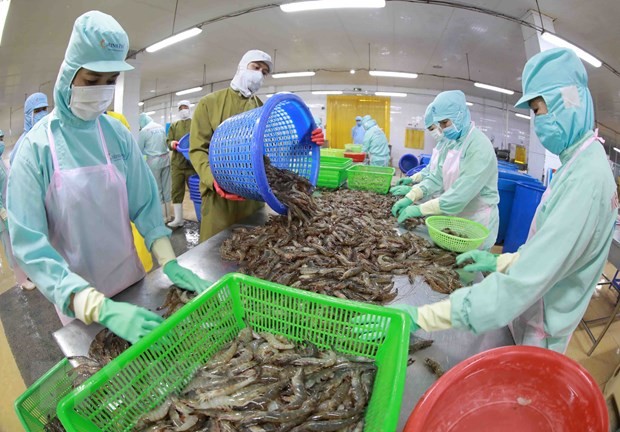 Vietnam's export value in August reached US$893.8 million from seafood products. VNA/VNS Photo
Vietnam's export value in August reached US$893.8 million from seafood products. VNA/VNS Photo
Of which, the export value of major agricultural products in the eight months was estimated at $15 billion, while the value stood at $11.8 billion from forest products, $7.5 billion from seafood products and $258.6 million from livestock products.
In August, the export value from these products reached nearly $4.4 billion, a rise of 32 percent year on year and 0.3 percent month on month.
During the first eight months, the trade value of these products was estimated to reach $66.2 billion, up 8.7 percent on the year. Therefore, the agriculture sector enjoyed a trade surplus of $6.3 billion in that period, a surge of 94.6 percent over the same period last year.
In January-August, seven products gained export value exceeding $2 billion, including coffee, rubber, rice, vegetables and fruits, cashew nuts, shrimp, and wooden furniture.
Many products saw an upturn in exports, such as coffee (40.3 percent), rubber (8.1 percent), rice (8.1 percent), peppercorn (8.2 percent), cassava (22.5 percent), tra fish (82.6 percent), shrimp (22 percent), and furniture (6.5 percent).
However, a downturn was also recorded in some other products, including vegetables and fruits (13.9 percent), cashew nuts (nearly 10.4 percent), and livestock products (12.3 percent).
In the first eight months of this year, Asia remained the major market for Vietnamese agro, forestry and seafood products, accounting for 43.1 percent of the total export volume, while America ranked second with 28.9 percent and Europe third with 11.8 percent.
The US continued to be the largest export market of those products, with revenue of about $9.6 billion, followed by China with $6.5 billion and Japan with $2.7 billion.
In the first eight months, the agriculture sector exported valuable and quality products to many countries, such as mango, dragon fruit, passion fruit, longan and lychee, especially those with big markets such as the EU, US, Australia, Japan, South Korea, New Zealand, China, Middle East and ASEAN.
For the seafood industry, the number of products and enterprises with export licensees increased, including in markets with high food quality and safety requirements.
The US continued to give export licenses to six more local enterprises to ship tra catfish products to this market, bringing the total number of enterprises with the licenses to 19. The EU also permitted 14 more enterprises to export seafood to this bloc, bringing the number of eligible enterprises up to 531.
According to the ministry, this year's agriculture sector will complete negotiations to export longan to Japan and continue to negotiate on exporting passion fruit and coconut to the US, pomelo to South Korea, passion fruit to Australia, and citrus fruit to New Zealand.
It will also continue to remove obstacles related to new regulations of China for Vietnam's export seafood.
The MARD is working with Vietnam's embassies and offices abroad to expand export markets for local agro, forestry and seafood products, especially China, US, EU, Russia, Japan, South Korea, ASEAN and Middle East markets.
It is also implementing bilateral and multilateral free trade agreements and supporting people and businesses in producing products to meet export requirements.
























